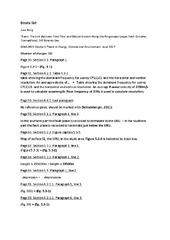| dc.contributor.advisor | Bünz, Stefan | |
| dc.contributor.author | Berg, June | |
| dc.date.accessioned | 2017-10-05T07:36:19Z | |
| dc.date.available | 2017-10-05T07:36:19Z | |
| dc.date.issued | 2017-06-06 | |
| dc.description.abstract | This master thesis has focused its efforts to investigate the link between glacial erosion and focused fluid flow in the SW Barents Sea, on the shallow bank area of Tromsøflaket where the Ringvassøy-Loppa Fault Complex borders the Tromsø basin in west, and the Loppa High in east. Here, large, elongated depressions are identified on the buried Upper Regional Unconformity (URU) and may resemble tunnel valleys or are related to fluid flow and gas hydrate formation beneath the Barents Sea ice sheet. The thesis is based on a 3D seismic dataset, the Caliente 3D, two sets of 2D seismic lines (the SH-8601 and SH-9103) and well data from two wells (well 7120/1-1 and 7120/1-2).
Mapping of faults, stratigraphy and amplitude anomalies revealed that vertical fluid migration are dominated by the faulted nature of the study area, which promote leakage of deep thermogenic gas into shallow Tertiary units. Above the base Tertiary reflector a change from vertical to lateral migration is observed. Together with the faults, the shallowing seismic stratigraphy focusses fluid migration towards the Loppa High in East and where the permeable carrier beds are truncated by the URU. Four elongated deep depression, with well-developed bases and sides are identified on the URU, these exhibit clear orientations reminiscent of paleo ice stream directions on the Barents Sea shelf. Several theories for their generation is argued, relating them to tunnel valleys and hill-hole pairs. The spatial relation of the depressions with the fluid flow system within the study area suggests that focussed fluid flow and glacial erosion are likely to have played a major part in their origin. Eventually a four-stage conceptual model is inferred for their formation, where localized formation of gas hydrates create sticky spots underneath the Barents Sea Ice Sheet, and a weak decollement failure plane at the base of the fluctuating GHSZ leads to glacial erosion of the depressions and re-deposition of the gas hydrate bearing sediments | en_US |
| dc.identifier.uri | https://hdl.handle.net/10037/11623 | |
| dc.language.iso | eng | en_US |
| dc.publisher | UiT The Arctic University of Norway | en_US |
| dc.publisher | UiT Norges arktiske universitet | en_US |
| dc.rights.accessRights | openAccess | en_US |
| dc.rights.holder | Copyright 2017 The Author(s) | |
| dc.rights.uri | https://creativecommons.org/licenses/by-nc-sa/3.0 | en_US |
| dc.rights | Attribution-NonCommercial-ShareAlike 3.0 Unported (CC BY-NC-SA 3.0) | en_US |
| dc.subject.courseID | EOM-3901 | |
| dc.subject | VDP::Matematikk og Naturvitenskap: 400::Geofag: 450 | en_US |
| dc.subject | VDP::Mathematics and natural science: 400::Geosciences: 450 | en_US |
| dc.title | The link between fluid flow and glacial erosion along the Ringvassøy- Loppa fault complex, Tromsøflaket, SW Barents Sea | en_US |
| dc.type | Master thesis | en_US |
| dc.type | Mastergradsoppgave | en_US |


 English
English norsk
norsk

